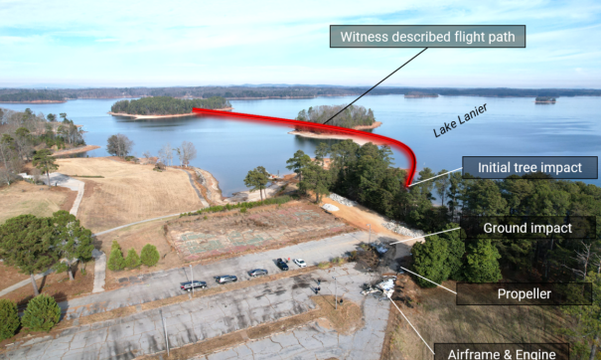According to a witness to the crash of a small plane at Lake Lanier Island last month that killed sole occupant of the craft, the plane was flying low over the water before it struck some trees near the shoreline, crashed and exploded.
That’s part of a preliminary report from the National Transportation Safety Board (NTSB) which was released this week. Killed in the crash was the owner of the plane, Howard Lee Joe, 60, Dunwoody, Georgia.
“According to a witness who was near the accident site,” the report says, “he saw the plane flying low over the water from west to east and then enter a right bank towards a tree line along the shoreline. The airplane subsequently impacted the trees, then abruptly descended and impacted a parking lot. Simultaneously with the impact, the airplane exploded, and a large fire developed around the entire airplane.” Another witness near the crash site heard the plane’s impact with trees.
The report goes into detail about the plane’s flight prior to the crash and the condition of engine components and other parts of the craft.
HERE IS AN EXCERPT AS IT APPEARS IN THE REPORT:
“All major portions of the airframe were located in one compact area. The airframe sustained
severe thermal damage, however, the engine sustained limited thermal damage. Flight control
continuity was established from all primary flight control surfaces to the cockpit except for
separations consistent with impact forces or thermal damage.
“The cockpit sustained severe thermal damage and all switches, levers, and flight instruments
were thermal or impact damaged. The Garmin G1000 sustained severe thermal damage and
the SD card installation areas were located; however, three of the four slots did not contain SD
cards. The one card located sustained severe thermal damage.
“The flap actuators were consistent with a retracted flap position. The landing gear was found
retracted.
“The majority of the fuel system was not observed due to thermal damage. The fuel selector
valve was not observed in the wreckage. The fuel strainer screen normally housed in the fuel
selector was found loose in the wreckage and it had sustained thermal damage. About 10
gallons of fuel was recovered from the right main tank. The left main tank was consumed by
fire.
“The firewall largely protected the engine from severe thermal damage. The No. 6 cylinder
rocker cover was cracked, consistent with impact related damage. There was no other major
external damage noted to the engine.
“The propeller flange and hub had separated from the engine and was located in the debris
path. All three propeller blades remained attached to the hub. One blade exhibited s-bending,
tip curling, and chordwise scratching. A second blade exhibited tip curling and chordwise
scratching. The third blade remained relatively straight and contained a lesser amount of
chordwise scratching. “The airplane was retained for further examination.”
A final report on the investigation may not be finished for another or so.
(Pictured: Drone image of the accident site and the witness described flight path (red line). Image courtesy Hall County Sheriff’s Office.)


